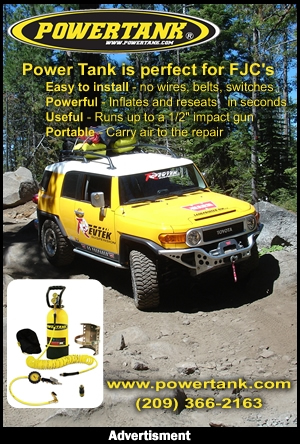In the rear, you simply add springs to provide lift for your FJ. Since the stock FJ suspension has a natural ‘rake’ (it leans slightly forward) most lift kits also have the effect of leveling your truck. The most popular kits provide 2” of lift in the rear and 3” of lift in the front, known simply as a 3” lift kit.
Ok, now that we have the basics covered, let’s get into springs. When you order your lift kit, you usually have an option of which spring rate you’d like. Your choices are most likely “Stock” “Medium” or “Heavy” (in the case of Old Man Emu (OME) lifts). But what do these rates really mean?
The ‘rate’ (or strength) of any spring is determined by a number of factors:
• Diameter of the wire used to create the spring
• Length of the wire used
• Diameter of the finished coil
• Number of coils
To explain further, a ‘heavier’ spring will either have a larger diameter wire, more coils, etc. When you buy an OME Medium spring for your FJ, for example, it is meant for approximately 110lbs more weight on the front of your truck (a steel bumper, for example). If you have even more weight (a very heavy front bumper + winch), you may opt to go with a heavier rate spring.
The problem with heavy (or sometimes even medium weight) springs is that you sacrifice ride quality. A spring that’s built to handle significantly more weight will (generally) make the ride of your FJ Cruiser stiffer and (some say) less comfortable.
Some manufacturers have springs that are specifically designed to perform like the stock springs for ride comfort, yet handle additional weight. By optimizing the wire diameter, number of coils, and other factors, companies like Toytec Lifts and Icon Vehicle Dynamics have created ‘super” coils that offer the best of both worlds. We recently installed a set of Toytec’s Superflex coils on our TRD FJ, so we’ll report back on how they perform in future issues.
So which spring is right for you? The only way to know that is to answer some basic questions:
-How much lift do I want? ~ Heavier springs usually give more lift.
-What will my payload be? ~ You’ll want to match your springs to the cargo (and mods like bumpers) you’ll be carrying.
-How much do I care about the ‘stock’ FJ ride? ~ Any modification will affect the ride of your FJ, so make sure you know all the pro’s and con’s before you decide which way to go.
Do you have a testimonial (positive or negative) about your aftermarket springs? We’d love to hear about it! Checkout this article online and let us know your thoughts in the Comments section.
OR 101: Coil Springs
- Details
- By TCT Magazine
For this installment of Off Road 101, we wanted to briefly discuss the technical details of a key aspect of your suspension: Coil Springs (or just springs).
When you lift your FJ Cruiser (unless you’re going with a spacer lift), you’ll be adding aftermarket springs to all four corners of your truck. In the front, you’ll replace the ‘coilover’ with a new spring and possibly new shocks. Depending on the option you choose, your new front suspension may be adjustable, meaning you can adjust the amount of lift by spinning the spring seat up or down. Yes, this is a simplified explanation, but it will do for our purposes.







